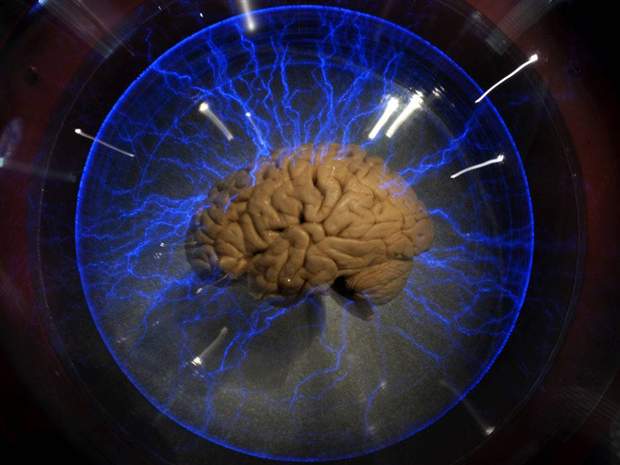
A human brain is displayed inside a glass box in Sao Paulo, Brazil.
Ask any high school biology student and they’ll tell you: brain cells communicate through electrical impulses, a current that flows from neuron to neuron, delivering messages in a flash.
But scientists at the University of Calgary have theorized a radical addition to that picture, suggesting the brain also uses a system of light-based communication, a sort of fibre-optic network for the mind.
Using sophisticated computer modeling, they suggest in a new journal article it’s at least plausible that photons – light’s fundamental particles — zip back and forth along biological cables linking parts of the brain.
If true, the existence of optical communication channels could help unravel some of the vast unknowns about the organ, including the mystery of how collections of molecules manage to generate consciousness itself, the Calgary teams says.
It’s definitely in the category of things that would be awesome if true … It would open up a whole new window on the brain
“It’s an idea that is a little bit out there,” admits Christoph Simon, the quantum physicist who spearheaded the study. “(But) it’s definitely in the category of things that would be awesome if true … It would open up a whole new window on the brain.”
Simon says the idea came to him after learning that certain brain cells – and some cells elsewhere in the body – actually produce photons through normal metabolism.
And it seemed that axons – the thread-like part of a nerve cell that transmits signals to other cells – and their protective myelin sheath could act as the conductor for those “bio-photons.”
The model developed by Simon and his colleagues – who include a biophysicist in the university’s oncology department – tested whether it would be physically possible for the axons to conduct light, and concluded it would.
Whether it’s actually happening has still to be proven. But a light communication system could transmit information tens of millions of times faster than the electrical sparking between neurons we already know about, Simon says.
And more importantly, he notes, it could allow for the transmission of quantum information. That’s the basic stuff of quantum theory, the Alice-in-Wonderland world of atomic and sub-atomic particles, where the classical laws of physics go out the window and something can be two things at once, or two places at the same time.
Such wild and wooly qualities have fueled the race to try to create hugely powerful quantum computers. Maybe nature seized on the same potential, Simon speculates. If so, it might hold the clue to how the brain produces the state of consciousness, a riddle that has so far stumped researchers.
“We know that the photons are there, and photons are really good for sending signals,” he said. “It would seem kind of natural for evolution to have found that, too.”
Outside experts admitted to being fascinated by the theory, but say they’re not convinced.
The Calgary team has compellingly shown that it is possible for axons to conduct light, says Ravi Menon, a medical biophysicist at Western University and part of its BrainSCAN project.
But the brain’s production of photons is “weak,” so it seems doubtful that it is actually using optics as a form of communication, he said.
“It’s obviously going to be controversial,” said Menon about the theory. “But that is good … Controversy is good.”
Even if there is no optical communication network in the brain, the research does suggest those theoretical “light pipes” could be used for research into neurological structures or even treatments, he said.
“It opens the possibility that you could shine light in one area and that light could be piped via the axons to another area … and excite or inhibit other areas,” said Menon.
The Calgary work is definitely “intriguing” and seems to have established the physical feasibility of optical communication in the brain, echoed Nancy Forde, a biophysicist at Simon Fraser University.
“Whether or not biology may exploit this photonic — light-based — communication is a completely different question,” she said via email.
Simon and his team suggest a number of experiments that could be conducted with brain matter to try to prove the theory, the simplest being to illuminate a brain slice at one end, then see if corresponding bright spots appear at the other end of the axons.
He said he is discussing with scientists in various fields taking the work further.
National Post
• Email: tblackwell@nationalpost.com | Twitter:



Comments